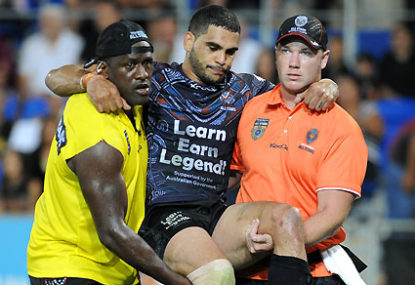The annual NRL All-Star game is purportedly facing the axe. Should the game be preserved? Or is it a tired, American-style concept that’s too complex to implement successfully?
Alternatively, would an Indigenous side prosper by playing competitive games against international opposition?
The Indigenous All-Stars will face a World All-Star team – despite the World All-Stars looking more like the All-Availables owing to a spate of withdrawals – for the first time in the preseason curtain raiser at Lang Park on Saturday.
So far nine of the original 20 All-Star nominees – including Sam Burgess, Trent Hodkinson, Robbie Farah, Paul Gallen and Roger Tuivasa-Sheck – have withdrawn, as has Indigenous All-Star skipper Johnathan Thurston, validating the annual fears of dwindling public interest and mounting player welfare issues.
After this weekend, the concept resides in limbo, having yet to be renewed for next year.
So why do we even have the game?
Select games involving invited players have been around for as long as sport has been organised – including famous teams like rugby’s Barbarians, established in 1890.
The earliest All-Star Game was played by Major League Baseball in 1933, as part of the Chicago World Fair. Baseball – as with the NHL, NFL and NBA – benefits from an ideal set of circumstances for the implementation of an All-Star game.
In these sports, the American-based leagues are the pinnacle. International competition is either cast aside, non-existent, or simply lost in the shadow of these multibillion-dollar corporate behemoths.
Additionally, each league is split into two or more conferences (the American and National leagues in baseball, the AFC and NFC in NFL etc.) making for a natural split in the league.
As such, the All-Star game is a proxy for international representative honours in the sport.
These exhibition games – where the emphasis for players is on being selected, not winning – often descend into farce. The NFL’s Pro Bowl is typified by minimal, ‘soft’ contact, while the other mid-season exhibitions support novelty sideshows such as the Home Run Derby or Slam Dunk Contest.
The concept of an Indigenous rugby league representative side has been around since 1973, refined into a regular pre-season game in 2010 by former Gold Coast Titan Preston Campbell.
The game has been used to showcase Indigenous culture and talent, but is now under threat.
But having an NRL All-Star game at all is unconventional.
For a start, rugby league is a sport where representative matches such as Origin still play a key role. Is there really a need to reward the NRL’s best with another representative obligation?
There is an argument to say there is, especially as the international game is not as extensively played as it could be, resulting in a dearth of playing opportunities for the game’s best.
In that case, selecting an Indigenous Australia team to play the Pacific Island nations around the same time as Origin, or in an international window, would be a better idea.
Perhaps a game against New Zealand Maori, as seen in the 2008 World Cup, would work in conjunction with the Anzac game?
An increased interest and proliferation in international fixtures would help, but this might happen organically, leading up to the 2017 World Cup. Perhaps the enticing prospect of Mal Meninga vs Wayne Bennett for future Australia vs England games might spark a renewed Ashes rivalry and more Test matches?
The biggest problem with this idea is the best Indigenous players would likely miss out, opting for Origin or international selection instead, which could inadvertently devalue the recognition offered.
But this idea offers a significant opportunity for an Indigenous side to play competitive, representative football, free from the inconvenience of being crammed into an awkward preseason slot.
The Indigenous All-Star game is already so much more than just a game.
There is a very credible argument that suggests that sport and politics should not mix, but that is not always the case.
FC Barcelona played a key role in preserving Catalanism in Spain, hence their motto, ‘Més que un Club’, Catalan for ‘More than a club’.
Similarly, the Gaelic Athletic Association was formed in 1884 to preserve Ireland’s traditional sports, as well as promote the Irish language and other aspects of Irish culture during British occupation.
The Indigenous All-Stars are playing that same role for Indigenous Australians now, showcasing their culture and talents to the world through the medium of sport.
On Saturday, the Indigenous All-Stars will wear the ‘RECOGNISE’ branded ‘R’ on their jerseys.
RECOGNISE is the movement to recognise Aboriginal and Torres Strait Islander peoples in Australia’s constitution, a huge step towards reconciliation.
Sam Thaiday led the chorus of distinguished voices clamouring for the NRL to retain the All-Stars game in some form this week, highlighting the important work the game allows for in the community.
Thaiday told the NRL website “Being with the community is the most important part of this week. It’s not the 80 minutes on Saturday; it’s what we do with the young kids and elders in the community throughout the week.”
And he’s right. Sport can be a hugely important tool for social change.
The timing of the game is problematic – although it does tie in with the anniversary of the National Apology to the Stolen Generations. However, the fact remains that no player wants to get injured in what is a glorified pre-season friendly.
Converting Indigenous matches into competitive exercises against true representative teams would rejuvenate player and fan interest, and make the concept more sustainable.
If the All-Star match is to be abandoned, then a competitive Indigenous team must take its place.





























































































